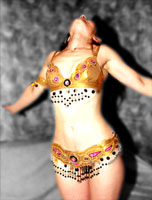Belly Dancing: Goddess Dancing
Mention belly dancing to most people and their
mind will turn to a dozen cliches. Inevitably these will be associated
with overt sexuality, skimpy costumes, Middle Eastern restaurants,
or even strippers.
 The
truth is that belly dancing is one of the oldest forms of dance
on earth, one that has a long tradition of celebrating female fertility,
power, and sensuality. It's roots lie in ritual worship of Earth
goddesses, and in feminine expression of the divine. The movements
of the pelvis and belly are symbolic of the mystery of sex, childbirth
and death. The
truth is that belly dancing is one of the oldest forms of dance
on earth, one that has a long tradition of celebrating female fertility,
power, and sensuality. It's roots lie in ritual worship of Earth
goddesses, and in feminine expression of the divine. The movements
of the pelvis and belly are symbolic of the mystery of sex, childbirth
and death.
According to Belly Dancing, a book by Rosina Fawzia Al-Rawi,
belly dancing's origins lie in primitive hunter gatherer societies,
when matriarchal religion was practiced through the movement of
the body. People danced to gain blessings, to celebrate, and to
mourn.
In ancient Babylonia, the goddess Ishtar was worshipped through
dance. A myth from this time tells of Ishtar's journey to the underworld,
to take back her husband. She wore seven veils, and at each gate
removed a veil and danced seductively, thereby gaining entrance.
While she was in the underworld, the earth remained unchanged, and
no birds or animals stirred. After dropping the seventh veil and
revealing her secret, she returned with her husband, covering herself
as she went.
Today, the Dance of the Seven Veils is mainly associated with stripping
for a male audience, however the true dance is far more meaningful
and symbolic.
As the linear and male-dominated societies of Greece and Rome came
to dominance, belly dancing and feminine, nature-based religion
were shunted aside, relegated to a secondary or hidden role. The
professional female dancer emerged, performing an altered version
of the female pelvic dance for the amusement of men, rather than
in homage to the Goddess, or as an expression of the self. Often
professional dancers were also prostitutes, and thus the image of
the belly dancer became associated with lust and profanity.
As Christianity took hold, so did a strongly anti-sex
and anti-dancing aesthetic. In order to commune with God, one had
to spurn the body. Women were opressed, and the dance was performed
in secret, or among the peasant folk. The travelling gypsies kept
the tradition alive, adapting it as they moved around Europe, the
Middle East, and North Africa.
In Muslim countries, women continued to dance, but only among themselves,
away from the men. There it evolved into a method of self expression,
and an altered way of worshipping the divine, albeit the new One
God. In Egypt and Turkey, the dance has a cabaret performance aspect
that is often frowned upon, but is still immensely popular
Today, belly dancing is taking hold in Westernised countries as
women rediscover an ancient way of expressing their femininity and
sexuality. The new challenge is to overcome the old stereotypes
that surround the dance, and to elevate it to an artform.
|

 The
truth is that belly dancing is one of the oldest forms of dance
on earth, one that has a long tradition of celebrating female fertility,
power, and sensuality. It's roots lie in ritual worship of Earth
goddesses, and in feminine expression of the divine. The movements
of the pelvis and belly are symbolic of the mystery of sex, childbirth
and death.
The
truth is that belly dancing is one of the oldest forms of dance
on earth, one that has a long tradition of celebrating female fertility,
power, and sensuality. It's roots lie in ritual worship of Earth
goddesses, and in feminine expression of the divine. The movements
of the pelvis and belly are symbolic of the mystery of sex, childbirth
and death.